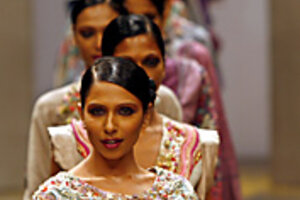India's colorful catwalk catches the world's eye
Nearly half the buyers at India Fashion Week, held this month, came from abroad.

Showcase: Models sported local designs at India Fashion Week in New Delhi.
Vijay Mathur/Reuters
New Delhi
As a shapely woman in a clinging purple dress sashays down the ramp at India Fashion Week, a chorus of hoots fills the crowded hall.
Foreign buyers in the front row look bewildered by the excitement over this shorter-than-average model – not the gaunt types normally seen on Paris catwalks. Few of them know she is an adored Bollywood actor, Celina Jaitley.
Indian Fashion Week, which was held in New Delhi March 12-16, featured many such disjointed moments; not surprising, since the event brought together two different worlds: India's fledgling designer clothing industry and the mammoth global fashion business it wants to join.
As India speedily globalizes, its fashion industry is no exception. The country is one of the fastest-growing markets in the world for international luxury brands. And the global fashion industry, in turn, is increasingly enamored with India's homegrown designers.
Global audience in the front row
Only eight years after the country's first Fashion Week, some 70 of the 150 buyers who attended this month's event were from other countries, according to Sumeet Nair, executive director of the Fashion Design Council of India (FDCI), which organized the event.
"There's a sea change going on in the Indian fashion business," he says. "It's not just that our designers are becoming professional and sales are rising; there's a whole industry growing up around them, from stylists to set designers."
As he spoke, Mr. Nair gestured around him at the setting of India's Fashion Week, a clean, airy space with black-and-white furniture designed by the FDCI in a corner of Pragati Maidan, a crumbling concrete conference center in central Delhi.
Outside, stray dogs sniffed piles of stinking litter. But inside, fashionistas in vertiginous heels and short frocks rushed from show to show clutching skinny lattes.
India's fashion business is still small: Indian designer-wear is thought to generate between $50 million and $250 million in sales in a market segment worth some $35 billion.
But new designers are quick to point out that a year ago, no Indian designer had shown at Paris Fashion Week. Since last October, three of the country's brightest fashion stars – Manish Arora, Anamika Khanna, and Rajesh Pratap Singh – have done so.
Watching the catwalk from the front rows, buyers from boutiques in North America, Europe, Japan, and the Middle East said they were eager to scout out new Indian talent.
Mary Symons nodded with delight as she sat watching models parade in the designs of Monica Jaising, whose designs sell well across the globe. Ms. Symons is a buyer for Indiva, a 12,000-square-foot, two-story boutique that opened in Toronto last year to introduce prosperous Canadian women to Indian designers.
"I'm going to add to my order," she said, as she came out of the show, beaming.
Alan Bilzerian, who owns the eponymous store in Boston, has long stocked clothing by Rajesh Pratap Singh, whose minimalist style is a big hit overseas. But this was the first time he'd attended Fashion Week here.
"You get this sense that this is the time to come looking for new designers in India," he says. "The market's still in its in its diapers, but it's going to grow and grow."
Buyers like himself, Mr Bilzerian says, are looking for a marriage of India's glorious textiles and centuries-old artisanship with silhouettes and cuts that could compete with those of Western designers.
Many of the designers who achieve recognition globally have received training in the West. Bilzerian says he's keeping his eye on designer Gaurav Gupta, who studied fashion at the reputable Central Saint Martins College of Art and Design in London.
"I don't think of myself as an Indian designer at all; anyone anywhere in the world could wear my designs," says Mr. Gupta.
International designers have long imported colorful textiles from India. Diana Vreeland, an editor of Vogue in the 1960s, once quipped that hot pink is the navy blue of India, an allusion to the fact that even India's most practical, workaday color is startling.
The textiles industry remains vibrant: Some 35 million Indians are employed in the production of cotton, silk, jute, and wool textiles, which constitute one-third of India's exports.
Beyond the Indian market
But however beautiful the raw materials, getting the cut right for the foreign market can be tough.
"The colors are beautiful and the fabrics are good, but the design sense needs to be improved," says Katsuhiro In, a buyer from the trendy Beams store in Tokyo, who attended India Fashion Week for the first time this year. Many foreign buyers agreed.
Part of the problem is that, while young designers would like to become stars on the international scene, their sales are still dominated by the Indian market.
Some 85 percent of sales at an event like Fashion Week are made by Indian buyers, who like more traditional subcontinental styles, according to Mr. Nair. He is lobbying the government to support its plans for a seven-acre fashion hub with a convention center, retail space, and a smart hotel on the outskirts of New Delhi to accelerate the growth of this market.
Tina Tahiliani, an expert on India's fashion industry, says Indian designers will become more focused as the industry matures.
"It takes a while for designers to get the experience they need," she says. "But we've got some young designers who are really going places."
